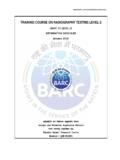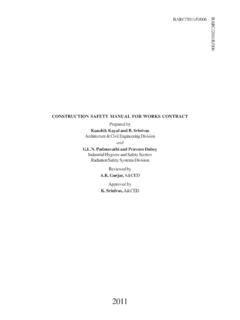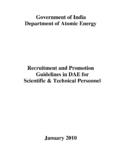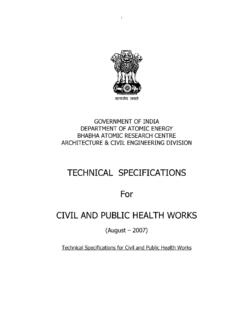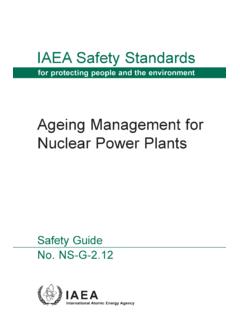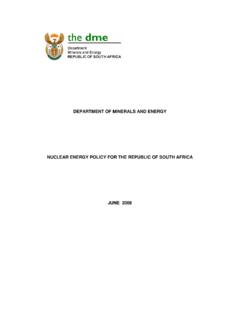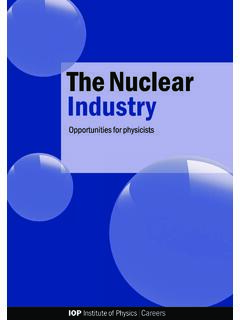Transcription of Accelerator Driven Reactor Systems
1 Accelerator Driven Systems (ADS)146 BARC HIGHLIGHTS Reactor Technology & Driven Reactor SYSTEMSThe Accelerator Driven system (ADS) is a new type of reactorwhich produces power even though it remains sub-criticalthroughout its life. All operating reactors in the world are critical reactors - which means that the number of neutronsproduced by fission is exactly balanced by the number lost byleakage and absorption by various materials in the balance is responsible for maintaining a constant reactorpower at any desired level. Sub-critical reactors produce fewerneutrons by fission than are lost by absorption and leakage, andrequire an external supply of neutrons to maintain a constantreactor power. This external neutron supply comes from theinteraction of a high energy proton beam with a heavy atomnucleus such as lead through what is known in nuclear physics asspallation. The power level in an ADS is greater for strongerexternal sources and for reactors which are closer to critical.
2 Such reactors were conceived by the Nobel laureate physicist,Carlo Rubbia (Report CERN/AT 95-53) and his team at CERN,among others, for power generation, but have caught theattention of the world for an equally important role - that ofburning nuclear waste. It is well known that nuclear reactorsgenerate radioactive waste which retains its radio-toxicity formillions of years and disposal of this waste has been a majorsource of public concern. The new Reactor is designed to safelytransmute the waste into stable elements or those whose radio-activity is relatively short lived, while producing useful interest in ADS has an additional dimension, which isrelated to the planned utilisation of its large thorium reserves forfuture nuclear energy generation. Thorium has the addedadvantage that it produces much less quantities of long livedradioactive wastes as compared to uranium. However, thoriumby itself is not fissile and must be first converted to fissile U-233by neutron irradiation, a process called breeding.
3 In ADS, theaccelerator delivers additional neutrons over and above thosecoming from fission. Moreover long term reactivity changes dueto burnup are not controlled using parasitic absorber ADS is, therefore, expected to possess superior breedingcharacteristics as compared to critical reactors. Since ADSreactors are not required to maintain criticality, it is possible toincrease burnup to extract more energy from a given massof fuel. This effect is rather large for thorium based fuel. Being anew type of Reactor , the ADS requires development of severaltechnologies related to high power accelerators, removal of theintense heat generated by the interaction of the high powerproton beam with the target, and associated computer simulations play a very important role indetermining the performance of the ADS Reactor . The studiesare geared to develop accurate computer simulation codes forADS, compile necessary nuclear data for this purpose, carry outexperimental and numerical tests regarding the adequacy of thesimulations and finally to use these simulations to evaluate ADSperformance with regard to the design objectives.
4 The state-of-the-art codes have been developed for carrying out fuelburnup simulations based on the exact Monte Carlo method andthe (accurate and quicker) multigroup transport theory methodfor this purpose. The codes are functional for fixed fuel ADS andare being put to use for evaluating some of the interesting ideasconceived for applications of ADS. Further development of thesecodes is being carried out to include fueling operations(insertion, removal, or shuffling) and it is expected to becompleted within a facility for carrying out experiments on the Physics of ADS isbeing set up at Purnima labs, BARC. A report on theexperimental program has been prepared and experiments willcommence once the facility becomes operational. Theexperiments will serve the equally important purpose of testingthe simulation methods under development. Measurement ofthe degree of sub-criticality is one such important experiment,as monitoring this parameter for ADS will be an important safetyrequirement.
5 This can be done by pulsing the Accelerator or bystudying tiny fluctuations in the Reactor power, called noise .A new theory of Reactor Noise in ADS has been developed and isgaining international Advanced Heavy Water Reactor (AHWR) is being designedand developed at BARC for the purpose of thorium view of the remarks on thorium utilization in ADS madeearlier, the following questions assume importance. What is thereduction in the annual fuel requirement of a thorium fuelledheavy water Reactor if operated in the ADS mode? Is a selfsustaining cycle possible? How much extra energy can beextracted from a given mass of fuel before it is discharged?What would be the Accelerator power required to drivesuch a Reactor ? Accelerator Driven Systems (ADS)147 Reactor Technology & Engineering BARC HIGHLIGHTSF igure shows the effect of recycling U-233 produced in thereactor after mixing it with thorium in different the discharged fuel contains somewhat largerU-233 than what is required for recycling at level,it is clear that a self sustaining cycle is comfortably possible witha multiplication factor of at a discharge burnup of 4% fuelmass.
6 Such a scheme requires about 15% of the producedenergy to be fed back to the Accelerator . Though this is a smallfraction the corresponding Accelerator power is still rather largefor a commercial sized power producing Reactor . As noted be-fore, use of light water instead of heavy water as coolant re-quires more Accelerator power. Clearly it is desirable to havesome means to effect a further one-way coupled fast-thermal ADS reactorconceived at BARC can be used for this purpose. This isillustrated in Figure. The neutron source produced by the inter-action of the proton beam with the target is first boosted ina small fast region (surrounding the target) having Pu as fissilematerial and a liquid metal coolant such as lead. These neutronsthen enter the main thermal Reactor region where most of thepower is produced. The outer region will be a heavy water mod-erated Reactor for which the technology is wellestablished.
7 Such an arrangement can considerably bring downthe Accelerator power requirements. It has the added advantagethat the inner booster region can be used for burning long livedwaste produced in our first and second generation reactors basedon uranium and plutonium such studies are required to evolve a suitable ADS designand the associated fuel cycle strategies forthorium utilization. The R&D program of the ThPD group onADS is geared to provide the necessary simulation tools and thetheoretical direction for this illustrate the use of the simulation codesfor answering such questions. Figure shows the maximummultiplication factor that is possible in a heavy water reactorwith thorium fuel in a once through cycle ( one which doesnot require reprocessing of thorium for recycling in thereactor). The initial fissile seed could be natural uranium or evenspent fuel from Pressurised Heavy Water Reactors (PHWRs).
8 Variation of average infinite multiplication factorof a Th bundle with burnupVariation of average infinite multiplicationfactor with , scheme allows 10% thorium (1 GWd/t is equivalent to fissionof 1% fuel mass) to be burnt before the fuel is , the energy gain is small and hence, a large fraction ofthe Reactor power (about 30%) would have to fed back to theaccelerator. If light water is used as the coolant, themultiplication factor is lower and the ADS would require greateraccelerator Driven Systems (ADS)148 BARC HIGHLIGHTS Reactor Technology & EngineeringSchematic of fast-thermal ADS

